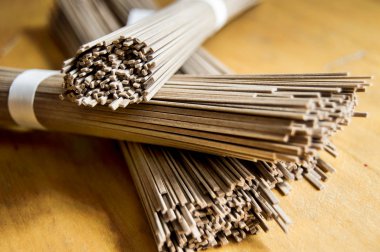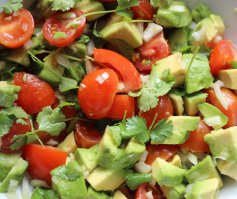Spelt pasta
 If we evaluated only its visual qualities, we would have to agree with the fact that spelt pasta is not one of the most beautiful. However, one cannot disagree with the fact that the brown colour ceases to be an obstacle when one thinks about the health-promoting qualities of this pasta. It not only supports the immune system, but also provides the body with fiber and protein. What is more, even diabetics can reach for it.
If we evaluated only its visual qualities, we would have to agree with the fact that spelt pasta is not one of the most beautiful. However, one cannot disagree with the fact that the brown colour ceases to be an obstacle when one thinks about the health-promoting qualities of this pasta. It not only supports the immune system, but also provides the body with fiber and protein. What is more, even diabetics can reach for it.
Of course, if we want to enjoy the taste, we must pay attention to the way in which it is prepared. The most serious mistake in this context seems to be boiling pasta, so it should be served at a time when it is still firm and elastic. The easiest way to evaluate its suitability for eating is to catch one thread and then cut it in half. If there is a slightly darker dot inside, it means that the pasta should still be cooked for some time. It is also worth remembering that spelt pasta has a quite specific, slightly nutty taste.
Spelt pasta - health properties
Spelt pasta attracts attention mainly because it is rich in protein, fibre and unsaturated fatty acids. However, it can also be used because of the wealth of minerals (including iron, potassium and calcium) and vitamins (vitamin PP, group B vitamins). Its regular consumption can even contribute to lowering blood cholesterol levels.
Spelt - health effects
Spelt is a solution that works both when our resistance decreases and when we start to run out of energy. It is therefore ideal in the autumn and winter, when the weather does not affect us favourably. The delicate nutty aftertaste allows the pasta to be served with root vegetables, walnuts, roasted almonds and sunflower seeds. It is also perfect for cocktail tomatoes, basil pesto and tomato sauce with the addition of lentils.
Maize noodles
 This specific yellow pasta is made from corn flour. It contains an impressive amount of fibre and is rich in vitamins E, B and A. If you add to this and the fact that it is a valuable source of magnesium and potassium and does not contain gluten, it is clear why it enjoys such a high reputation.
This specific yellow pasta is made from corn flour. It contains an impressive amount of fibre and is rich in vitamins E, B and A. If you add to this and the fact that it is a valuable source of magnesium and potassium and does not contain gluten, it is clear why it enjoys such a high reputation.
Soya noodles
Soya noodles can be a surprise, as it turns out that we do not get it from soya at all. Its composition is dominated by starch from mung beans, not only rich in protein, but also poor in fat. Soya noodles are long, transparent threads that do not contain gluten, and one of its biggest advantages is that it does not require cooking and can be consumed immediately after boiling. It is usually served with Asian cuisine, but there is nothing to prevent it from being fried in oil.
Soba noodles
 Soba is a pasta made from a combination of wheat and buckwheat flour. It is rich in protein, vitamins PP and B1 and antioxidants, and has a characteristic nutty aftertaste. Particularly suitable as an addition to soups and sauces.
Soba is a pasta made from a combination of wheat and buckwheat flour. It is rich in protein, vitamins PP and B1 and antioxidants, and has a characteristic nutty aftertaste. Particularly suitable as an addition to soups and sauces.
Buckwheat pasta
Buckwheat pasta does not contain gluten, so it is often recommended as a much healthier equivalent of classic pasta. It can be used both by patients with coeliac disease and people on a low-protein diet. Its advantage is its delicate taste and short preparation time, as it usually does not have to wait longer than six minutes. A hundred grams contain only 350 calories and as much as 2 grams of fibre. It also has much more magnesium and potassium than classic pasta. You can reach for it even if you are afraid of acidification of the body.
Rice noodles
Rice pasta is made with rice flour and attracts attention even if only because it does not require cooking. Not only does it contain no preservatives, but it is also free of artificial dyes. It is also an easily digestible product.
Rice pasta - characteristics
It is possible thanks to mixing water and rice flour, although tapioca and corn flour are often its ingredients. It is light enough to be eaten without worrying about weight gain, while low fat content goes hand in hand with large amounts of mineral salts, vitamins and proteins. It is also a valuable source of complex carbohydrates that not only add energy, but also improve well-being. The body digests it quite slowly, which means that our sense of satiety persists for a long time.
Rice pasta - price
 Rice pasta most often takes the form of thin threads, although the problem today is not the purchase of tubes or ribbons. What is important, it is not only tasty and low in calories, but also inexpensive. 200 grams of the product is usually an expense of 6 zlotys, and since there are many pasta producers of this type, we will find both cheaper and more expensive equivalents.
Rice pasta most often takes the form of thin threads, although the problem today is not the purchase of tubes or ribbons. What is important, it is not only tasty and low in calories, but also inexpensive. 200 grams of the product is usually an expense of 6 zlotys, and since there are many pasta producers of this type, we will find both cheaper and more expensive equivalents.
Rice pasta - recipes
Rice pasta is a product that does not require cooking, so if you pour boiling water over it, you will be able to start eating after just a few minutes. It fits perfectly with vegetables, chicken and seafood.














